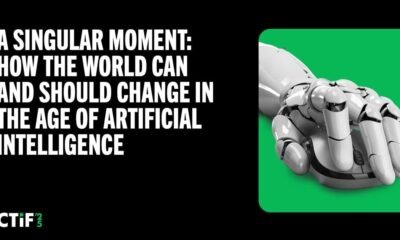Everest Nevraumont, a 10-year-old student at Alpha School Austin, scrolled through a lesson on a laptop Tuesday morning while U.S. Education Secretary Linda McMahon gazed over her shoulder. Nevraumont explained how she can go through the lessons, created by artificial intelligence, largely at her own pace.
Education
Multi-stakeholder perspective on responsible artificial intelligence and acceptability in education

Education stands as a cornerstone of society, nurturing the minds that will ultimately shape our future1. As we advance into the twenty-first century, exponentially developing technologies and the convergence of knowledge across disciplines are set to have a significant influence on various aspects of life2, with education a crucial element that is both disrupted by and critical to progress3. The rise of artificial intelligence (AI), notably generative AI and generative pre-trained transformers4 such as ChatGPT, with its new capabilities to generalise, summarise, and provide human-like dialogue across almost every discipline, is set to disrupt the education sector from K-12 through to lifelong learning by challenging traditional systems and pedagogical approaches5,6.
Artificial intelligence can be defined as the simulation of human intelligence and its processes by machines, especially computer systems, which encompasses learning (the acquisition of information and rules for using information), reasoning (using rules to reach approximate or definite conclusions), and flexible adaptation7,8,9. In education, AI, or AIED, aims to “make computationally precise and explicit forms of educational, psychological and social knowledge which are often left implicit“10. Therefore, the promise of AI to revolutionise education is predicated on its ability to provide adaptive and personalised learning experiences, thereby recognising and nurturing the unique cognitive capabilities of each student11. Furthermore, integrating AI into pedagogical approaches and practice presents unparalleled opportunities for efficiency, global reach, and the potential for the democratisation of education unattainable by traditional approaches.
AIED encompasses a broad spectrum of applications, from adaptive learning platforms that curate customised content to fit individual learning styles and paces12 to AI-driven analytics tools that forecast student performance and provide educators with actionable insights13. Moreover, recent developments in AIED have expanded the educational toolkit to include chatbots for student support, natural language processing for language learning, and machine learning for automating administrative tasks, allowing educators to focus more or exclusively on teaching and mentoring14. These tools have recently converged into multipurpose, generative pre-trained transformers (GPTs). These GPTs are large language models (LLMs) utilizing transformers to combine large language data sets and immense computing power to create an intelligent model that, after training, can generate complex, advanced, human-level output15 in the form of text, images, voice, and video. These models are capable of multi-round human-computer dialogues, continuously responding with novel output each time users input a new prompt due to having been trained with data from the available corpus of human knowledge, ranging from the physical and natural sciences through medicine to psychiatry.
This convergence highlights that a step change has occurred in the capabilities of AI to act not only as a facilitator of educational content but also as a dynamic tool with agentic properties capable of interacting with stakeholders at all levels of the educational ecosystem, enhancing and potentially disrupting the traditional pedagogical process. Recently, the majority of the conversation within the current literature concerning AIED is focused on the aspect of cheating or plagiarism16,17,18, with some calls to examine the ethics of AI19. This focus falls short of addressing the multidimensional, multi-stakeholder nature of AI-related issues in education. It fails to consider that AI is already here, accessible, and proliferating. It is this accessibility and proliferation that motivates the research presented in this manuscript. The release of generative AI globally and its application within education raises significant ethical concerns regarding data privacy, AI agency, transparency, explainability, and additional psychosocial factors, such as confidence and trust, as well as the acceptance and equitable deployment of the technology in the classroom20.
As education touches upon all members and aspects of society, we, therefore, seek to investigate and understand the level of acceptability of AI within education for all stakeholders: students, teachers, parents, school staff, and principals. Using factors derived from the explainable AI literature21 and the UNESCO framework for AI in education22. We present research that investigates the role of agency, privacy, explainability, and transparency in shaping the perceptions of global utility (GU), individual usefulness (IU), confidence, justice, and risk toward AI and the eventual acceptance of AI and intention to use (ITU) in the classroom. These factors were chosen as the focus for this study based on feedback from focus groups that identified our four independent variables as the most prominent factors influencing AI acceptability, aligning with prior IS studies21 that have demonstrated their central role in AI adoption decisions. Additionally, these four variables directly influence other AI-related variables, such as fairness -conceptualized in our study as confidence- suggesting a mediating role in shaping intentions to use AI.
In an educational setting, the deployment of AI has the potential to redistribute agency over decision-making between human actors (teachers and students) and algorithmic systems or autonomous agents. As AI systems come to assume roles traditionally reserved for educators, the negotiation of autonomy between educator, student, and this new third party becomes a complex balancing act in many situations, such as personalising learning pathways, curating content, and even evaluating student performance23,24.
Educational professionals face a paradigm shift where the agency afforded to AI systems must be weighed against preserving the educators’ pedagogical authority and expertise25. However, this is predicated on human educators providing additional needs such as guidance, motivation, facilitation, and emotional investment, which may not hold as AI technology develops26 That is not to say that AI will supplant the educator in the short term; rather, it highlights the need to calibrate AI’s role within the pedagogical process carefully.
Student agency, defined as the individual’s ability to act independently and make free choices27, can be compromised or enhanced by AI. While AI can personalise learning experiences, adaptively responding to student needs, thus promoting agency28, it can conversely reduce student agency through over-reliance, whereby AI-generated information may diminish students’ critical thinking and undermine the motivation toward self-regulated learning, leading to a dependency29.
Moreover, in educational settings, the degree of agency afforded to AI systems, i.e., its autonomy and decision-making capability, raises significant ethical considerations at all stakeholder levels. A high degree of AI agency risks producing “automation complacency“30, where stakeholders within the education ecosystem, from parents to teachers, uncritically accept AI guidance due to overestimating its capabilities. Whereas a low degree of agency essentially hamstrings the capabilities of AI and the reason for its application in education. Therefore, ensuring that AI systems are designed and implemented to support and enhance human agency through human-centred alignment and design rather than replacing it requires thorough attention to the design and deployment of these technologies31.
In conclusion, educational institutions must navigate the complex dynamics of assigned agency when integrating AI into pedagogical frameworks. This will require careful consideration of the balance between AI autonomy and human control to prevent the erosion of stakeholders’ agency at all levels of the education ecosystem and, thus, increase confidence and trust in AI as a tool for education.
Establishing confidence in AI systems is multifaceted, encompassing the ethical aspects of the system, the reliability of AI performance, the validity of its assessments, and the robustness of data-driven decision-making processes32,33. Thus, confidence in AI systems within educational contexts centres on their capacity to operate reliably and contribute meaningfully to educational outcomes.
Building confidence in AI systems is directly linked to the consistency of their performance across diverse pedagogical scenarios34. Consistency and reliability are judged by the AI system’s ability to function without frequent errors and sustain its performance over time35. Thus, inconsistencies in AI performance, such as system downtime or erratic behaviour, may alter perceptions of utility and significantly decrease user confidence.
AI systems are increasingly employed to grade assignments and provide feedback, which are activities historically under the supervision of educators. Confidence in these systems hinges on their ability to deliver feedback that is precise, accurate, and contextually appropriate36. The danger of misjudgment by AI, particularly in subjective assessment areas, can compromise its credibility37, increasing risk perceptions for stakeholders such as parents and teachers and directly affecting learners’ perceptions of how fair and just AI systems are.
AI systems and the foundation models they are built upon are trained over immense curated datasets to drive their capabilities38. The provenance of these data, the views of those who curate the subsequent training data, and how that data is then used within the model (that creates the AI) is of critical importance to ensure bias does not emerge when the model is applied19,39. To build trust in AI, stakeholders at all levels must have confidence in the integrity of the data used to create an AI, the correctness of analyses performed, and any decisions proposed or taken40. Moreover, the confidence-trust relationship in AI-driven decisions requires transparency about data sources, collection methods, and explainable analytical algorithms41.
Therefore, to increase and maintain stakeholder confidence and build trust in AIED, these systems must exhibit reliability, assessment accuracy, and transparent and explainable decision-making. Ensuring these attributes requires robust design, testing, and ongoing monitoring of AI systems, the models they are built upon, and the data used to train them.
Trust in AI is essential to its acceptance and utilisation at all stakeholder levels within education. Confidence and trust are inextricably linked42, representing a feedback loop wherein confidence builds towards trust and trust instils confidence, and the reverse holds that a lack of confidence fails to build trust. Thus, a loss of trust decreases confidence. Trust in AI is engendered by many factors, including but not limited to the transparency of AI processes, the alignment of AI functions with educational ethics, including risk and justice, the explainability of AI decision-making, privacy and the protection of student data, and evidence of AI’s effectiveness in improving learning outcomes33,43,44.
Standing as a proxy for AI, studies of trust toward automation45,46 have identified three main factors that influence trust: performance (how automation performs), process (how it accomplishes its objective), and purpose (why the automation was built originally). Accordingly, educators and students are more likely to trust AI if they can comprehend its decision-making processes and the rationale behind its recommendations or assessments47. Thus, if AI operates opaquely as a “black box”, it can be difficult to accept its recommendations, leading to concerns about its ethical alignment. Therefore, the dynamics of stakeholder trust in AI hinges on the assurance that the technology operates transparently and without bias, respects student diversity, and functions fairly and justly48.
Furthermore, privacy and security directly feed into the trust dynamic in that educational establishments are responsible for the data that AI stores and utilises to form its judgments. Tools for AIED are designed, in large part, to operate at scale, and a key component of scale is cloud computing, which involves resource sharing, which refers to the technology and the data stored on it49. This resource sharing makes the boundary between personal and common data porous, which is viewed as a resource that many technology companies can use to train new AI models or as a product50. Thus, while data breaches may erode trust in AIED in an immediate sense, far worse is the hidden assumption that all data is common. However, this issue can be addressed by stakeholders at various levels through ethical alignment negotiations, robust data privacy measures, security protocols, and policy support to enforce them22,51.
Accountability is another important element of the AI trust dynamic, and one inextricably linked to agency and the problem of control. It refers to the mechanisms in place to hold system developers, the institutions that deploy AI, and those that use AI responsible for the functioning and outcomes of AI systems33. The issue of who is responsible for AI’s decisions or mistakes is an open question heavily dependent on deep ethical analysis. However, it is of critical and immediate importance, particularly in education, where the stakes include the quality of teaching and learning, the fairness of assessments, and the well-being of students.
In conclusion, trust in AI is an umbrella construct that relies on many factors interwoven with ethical concerns. The interdependent relationship between confidence and trust suggests that the growth of one promotes the enhancement of the other. At the same time, their decline, through errors in performance, process, or purpose, leads to mutual erosion. The interplay between confidence and trust points towards explainability and transparency as potential moderating factors in the trust equation.
The contribution of explainability and transparency towards trust in AI systems is significant, particularly within the education sector; they enable stakeholders to understand and rationalise the mechanisms that drive AI decisions52. Comprehensibility is essential for educators and students not only to follow but also to assess and accept the judgments made by AI systems critically53,54. Transparency gives users visibility of AI processes, which opens AI actions to scrutiny and validation55.
Calibrating the right balance between explainability and transparency in AI systems is crucial in education, where the rationale behind decisions, such as student assessments and learning path recommendations, must be clear to ensure fairness and accountability32,56. The technology is perceived to be more trustworthy when AI systems articulate, in an accessible manner, their reasoning for decisions and the underlying data from which they are made57. Furthermore, transparency allows educators to align AI-driven interventions with pedagogical objectives, fostering an environment where AI acts as a supportive tool rather than an inscrutable authority58,59,60.
Moreover, the explainability and transparency of AI algorithms are not simply a technical requirement but also a legal and ethical one, depending on interpretation, particularly in light of regulations such as the General Data Protection Regulation (GDPR), which posits a “right to explanation” for decisions made by automated systems61,62,63. Thus, educational institutions are obligated to deploy AI systems that perform tasks effectively and provide transparent insights into their decision-making processes in a transparent manner64,65.
In sum, explainability and transparency are critical co-factors in the trust dynamic, where trust appears to be the most significant factor toward the acceptance and effective use of AI in education. Systems that employ these methods enable stakeholders to understand, interrogate, and trust AI technologies, ensuring their responsible and ethical use in educational contexts.
When taken together, this discussion points to the acceptance of AI in education as a multifaceted construct, hinging on a harmonious yet precarious balance of agency, confidence, and trust underpinned by the twin pillars of explainability and transparency. Agency involving the balance of autonomy between AI, educators, and students requires careful calibration between AI autonomy and educator control to preserve pedagogical integrity and student agency, which is vital for independent decision-making and critical thinking. Accountability, closely tied to agency, strengthens trust by ensuring that AI systems are answerable for their decisions and outcomes, reducing risk perceptions. Trust in AI and its co-factor confidence are fundamental prerequisites for AI acceptance in educational environments. The foundation of this trust is built upon factors such as AI’s performance, the clarity of its processes, its alignment with educational ethics, and the security and privacy of data. Explainability and transparency are critical in strengthening the trust dynamic. They provide stakeholders with insights into AI decision-making processes, enabling understanding and critical assessment of AI-generated outcomes and helping to improve perceptions of how just and fair these systems are.
However, is trust a one-size-fits-all solution to the acceptance of AI within education, or is it more nuanced, where different AI applications require different levels of each factor on a case-by-case basis and for different stakeholders? This research seeks to determine to what extent each factor contributes to the acceptance and intention to use AI in education across four use cases from a multi-stakeholder perspective.
Drawing from this broad interdisciplinary foundation that integrates educational theory, ethics, and human-computer interaction, this study investigates the acceptability of artificial intelligence in education through a multi-stakeholder lens, including students, teachers, and parents. This study employs an experimental vignette approach, incorporating insights from focus groups, expert opinion and literature review to develop four ecologically valid scenarios of AI use in education. Each scenario manipulates four independent variables—agency, transparency, explainability, and privacy—to assess their effects on perceived global utility, individual usefulness, justice, confidence, risk, and intention to use. The vignettes were verified through multiple manipulation checks, and the effects of independent variables were assessed using previously validated psychometric instruments administered via an online survey. Data were analysed using a simple mediation model to determine the direct and indirect effects between the variables under consideration and stakeholder intention to use AI.
Education
Victorian government partners with Cturtle to boost international alumni careers

TalentConnect is a Victorian government platform connecting skilled migrants and international professionals in cyber and digital technology with employers across Victoria, Australia.
The TalentConnect website is built by Cturtle using its proprietary TalentMatch technology on behalf of the Victorian government’s skilled and business migration program.
With a global talent shortage, and an estimated 84 million candidate shortfall by 2030, Cturtle’s mission is to helps companies, governments, and universities track and engage global talent and alumni by using big data and AI-driven insights.
While its TalentMatch feature connects international graduates, alumni and high demand global talent with jobs, Cturtle is also being used by universities across Australia, the UK and the US in a number of different ways.
There are ways that universities can use the data that we have to help their rankings. That’s always a huge focus of the universities
Shane Dillon, Cturtle
“There are ways that universities can use the data that we have to help their rankings. That’s always a huge focus of the universities,” Shane Dillon, founder of Cturtle, told The PIE.
Cturtle equips universities with verified graduate data including employment rates, salaries, industries, and job locations, aligned with global ranking metrics. This helps institutions showcase impact by program, degree level, and graduate demographic.
According to Dillon, universities are also using the platform to track and reconnect with alumni. “We’re tracking their employment data, we tend to also have up-to-date contact information, so the universities can use that,” said Dillon.
Cturtle identifies and tracks alumni – even those not active in alumni networks – providing universities with a clearer picture of graduate outcomes and mobility.
Having these data insights, through a database of 2.5 million international alumni employment and salary outcomes, can also be useful in demonstrating the return on investment to the prospective students, the Cturtle founder told The PIE.
With growing calls from students for greater transparency, Cturtle provides data on graduate outcomes — including salaries, industries, and employers — for individual academic programs. The aim is to support recruitment, strengthen trust, and help institutions stand out in an increasingly competitive global education market.
Education
Education Secretary McMahon visits Austin private school using AI mode
U.S. Education Secretary Linda McMahon meets Alpha School students Milam Morgan, 7, left, his brother Rivers Morgan, 5, and their parents Searcy and Brooks Morgan, during a tour of the Alpha School to highlight the importance of national AI literacy in Austin, Tuesday, Sept. 9, 2025.
Jay Janner/Austin American-Statesman“In reading, I’m grade nine, but in math I’m only grade five,” Nevraumont said. “In reading, I’ve advanced way faster.”
Article continues below this ad
U.S. Education Secretary Linda McMahon meets Alpha School students Rivers Morgan, 5, his brother, Milam, 7, left, and their parents Searcy and Brooks Morgan, during a tour of the Alpha School in Austin on Tuesday to highlight the importance of AI literacy.
Looking on, McMahon said the model was “the most exciting thing (she’s) seen in the education world in a long time.”
McMahon visited Alpha School, a private school in the Barton Hills area of Southwest Austin, to learn about its “2-hour learning” model, which uses AI-developed curriculum to teach core instruction.
The Austin visit was another stop on McMahon’s “Returning Education to the States” tour, in which she has so far visited roughly a dozen schools, following a March executive order from President Donald Trump to dismantle the Education Department.
Article continues below this ad
During the visit, McMahon praised the Alpha School’s use of AI as an opportunity for other schools to develop new tools for teachers.
“Let’s be motivated in our states and in our school systems to inspire them to be curious enough to come and understand what is happening here,” McMahon said.
U.S. Education Secretary Linda McMahon, left, and Alpha School co-founder MacKenzie Price, participate in a round table discussion at the Alpha School to highlight the importance of national AI literacy in Austin, Tuesday, Sept. 9, 2025.
Jay Janner/Austin American-StatesmanAlpha School, founded in 2014, has locations in Arizona, California, Florida and New York. A Houston location is set to open this winter.
Article continues below this ad
Students learn through AI-driven curriculum for two hours a day with assistance from adult staff members known as guides, rather than teachers. They spend the remaining hours of the school day developing practical skills in finance, entrepreneurship and public speaking through workshops or group projects.
This approach keeps students engaged and uses personalized instruction, said MacKenzie Price, co-founder of the national school.
“It’s time for us to all hold ourselves responsible for delivering better for these kids. I think that using artificial intelligence is what enables us to raise human intelligence, not just for the students but also for the teachers,” Price said.
Texas Education Commissioner Mike Morath, who also visited the school Tuesday, said AI use can be a tool when designed with sensitivity.
Article continues below this ad
Texas Education Agency Commissioner Mike Morath listens during a round table discussion with U.S. Education Secretary Linda McMahon at the Alpha School to highlight the importance of national AI literacy in Austin, Tuesday, Sept. 9, 2025.
Jay Janner/Austin American-Statesman“You have to know how the technology can be used, and used effectively, because if you don’t use it in the right way, it can either become districting or ultimately become harmful,” Morath said. “It just depends on how it is deployed.”
McMahon is the second education secretary to visit an Austin campus in just two years.
In March 2023, Miguel Cardona, who was education secretary under President Joe Biden, toured Webb Middle School in North Austin to promote bilingual education.
Article continues below this ad
McMahon’s visit comes as significant change is underway at the federal department.
A budget proposal released last week would reduce education spending by $12 billion, about 15%, in the 2026 fiscal year. The cuts would include reductions to Title I money, which helps fund school serving low-income students, but would increase funding for special education and charter schools.
U.S. Education Secretary Linda McMahon chats with Alpha School student Everest Nevraumont, 10, and school co-founder MacKenzie Price after a round table discussion to highlight the importance of national AI literacy in Austin, Tuesday, Sept. 9, 2025.
Jay Janner/Austin American-StatesmanMcMahon said part of the intention of her tour across the county is to understand the most effective education practices in each state.
Article continues below this ad
“That’s a big part of what we can do to help different schools in different areas to understand what might be available,” McMahon said.
Texas has leaned into additional options for technology in school in recent years.
In 2021, lawmakers passed legislation to increase options for virtual learning. In 2023, the State of Texas Assessments of Academic Readiness moved all-digital, rather than a paper and pencil test.
Article continues below this ad
Education
Prioritizing behavior as essential learning

Key points:
In classrooms across the country, students are mastering their ABCs, solving equations, and diving into science. But one essential life skill–behavior–is not in the lesson plan. For too long, educators have assumed that children arrive at school knowing how to regulate emotions, resolve conflict, and interact respectfully. The reality: Behavior–like math or reading–must be taught, practiced, and supported.
Today’s students face a mounting crisis. Many are still grappling with anxiety, disconnection, and emotional strain following the isolation and disruption of the COVID pandemic. And it’s growing more serious.
Teachers aren’t immune. They, too, are managing stress and emotional overload–while shouldering scripted curricula, rising expectations, and fewer opportunities for meaningful engagement and critical thinking. As these forces collide, disruptive behavior is now the leading cause of job-related stress and a top reason why 78 percent of teachers have considered leaving the profession.
Further complicating matters is social media and device usage. Students and adults alike have become deeply reliant on screens. Social media and online socialization–where interactions are often anonymous and less accountable–have contributed to a breakdown in conflict resolution, empathy, and recognition of nonverbal cues. Widespread attachment to cell phones has significantly disrupted students’ ability to regulate emotions and engage in healthy, face-to-face interactions. Teachers, too, are frequently on their phones, modeling device-dependent behaviors that can shape classroom dynamics.
It’s clear: students can’t be expected to know what they haven’t been taught. And teachers can’t teach behavior without real tools and support. While districts have taken well-intentioned steps to help teachers address behavior, many initiatives rely on one-off training without cohesive, long-term strategies. Real progress demands more–a districtwide commitment to consistent, caring practices that unify educators, students, and families.
A holistic framework: School, student, family
Lasting change requires a whole-child, whole-school, whole-family approach. When everyone in the community is aligned, behavior shifts from a discipline issue to a core component of learning, transforming classrooms into safe, supportive environments where students thrive and teachers rediscover joy in their work. And when these practices are reinforced at home, the impact multiplies.
To help students learn appropriate behavior, teachers need practical tools rather than abstract theories. Professional development, tiered supports, targeted interventions, and strategies to build student confidence are critical. So is measuring impact to ensure efforts evolve and endure.
Some districts are leading the way, embracing data-driven practices, evidence-based strategies, and accessible digital resources. And the results speak for themselves. Here are two examples of successful implementations.
Evidence-based behavior training and mentorship yields 24 percent drop in infractions within weeks
With more than 19,000 racially diverse students across 24 schools east of Atlanta, Newton County Schools prioritized embedded practices and collaborative coaching over rigid compliance. Newly hired teachers received stipends to complete curated, interactive behavior training before the school year began. They then expanded on these lessons during orientation with district staff, deepening their understanding.
Once the school year started, each new teacher was partnered with a mentor who provided behavior and academic guidance, along with regular classroom feedback. District climate specialists also offered further support to all teachers to build robust professional learning communities.
The impact was almost immediate. Within the first two weeks of school, disciplinary infractions fell by 24 percent compared to the previous year–evidence that providing the right tools, complemented by layered support and practical coaching, can yield swift, sustainable results.
Pairing shoulder coaching with real-time data to strengthen teacher readiness
With more than 300,000 students in over 5,300 schools spanning urban to rural communities, Clark County School District in Las Vegas is one of the largest and most diverse in the nation.
Recognizing that many day-to-day challenges faced by new teachers aren’t fully addressed in college training, the district introduced “shoulder coaching.” This mentorship model pairs incoming teachers with seasoned colleagues for real-time guidance on implementing successful strategies from day one.
This hands-on approach incorporates videos, structured learning sessions, and continuous data collection, creating a dynamic feedback loop that helps teachers navigate classroom challenges proactively. Rather than relying solely on reactive discipline, educators are equipped with adaptable strategies that reflect lived classroom realities. The district also uses real-time data and teacher input to evolve its behavior support model, ensuring educators are not only trained, but truly prepared.
By aligning lessons with the school performance plan, Clark County School District was able to decrease suspensions by 11 percent and discretionary exclusions by 17 percent.
Starting a new chapter in the classroom
Behavior isn’t a side lesson–it’s foundational to learning. When we move beyond discipline and make behavior a part of daily instruction, the ripple effects are profound. Classrooms become more conducive to learning. Students and families develop life-long tools. And teachers are happier in their jobs, reducing the churn that has grown post-pandemic.
The evidence is clear. School districts that invest in proactive, strategic behavior supports are building the kind of environments where students flourish and educators choose to stay. The next chapter in education depends on making behavior essential. Let’s teach it with the same care and intentionality we bring to every other subject–and give every learner the chance to succeed.
-

 Business2 weeks ago
Business2 weeks agoThe Guardian view on Trump and the Fed: independence is no substitute for accountability | Editorial
-
Tools & Platforms4 weeks ago
Building Trust in Military AI Starts with Opening the Black Box – War on the Rocks
-

 Ethics & Policy1 month ago
Ethics & Policy1 month agoSDAIA Supports Saudi Arabia’s Leadership in Shaping Global AI Ethics, Policy, and Research – وكالة الأنباء السعودية
-

 Events & Conferences4 months ago
Events & Conferences4 months agoJourney to 1000 models: Scaling Instagram’s recommendation system
-

 Jobs & Careers2 months ago
Jobs & Careers2 months agoMumbai-based Perplexity Alternative Has 60k+ Users Without Funding
-

 Podcasts & Talks2 months ago
Podcasts & Talks2 months agoHappy 4th of July! 🎆 Made with Veo 3 in Gemini
-

 Education2 months ago
Education2 months agoMacron says UK and France have duty to tackle illegal migration ‘with humanity, solidarity and firmness’ – UK politics live | Politics
-

 Education2 months ago
Education2 months agoVEX Robotics launches AI-powered classroom robotics system
-

 Funding & Business2 months ago
Funding & Business2 months agoKayak and Expedia race to build AI travel agents that turn social posts into itineraries
-

 Podcasts & Talks2 months ago
Podcasts & Talks2 months agoOpenAI 🤝 @teamganassi





















